How to Check the Steering Rack Bushing?
The steering system is one of the most important components in a vehicle, ensuring the driver can safely and smoothly control the vehicle. Among these critical components, the steering rack is the core component responsible for converting the driver's steering wheel movements into wheel direction changes. The steering rack bushing, on the other hand, is a small but critical component within the steering rack system. The quality and condition of the bushing directly impact the performance and durability of the steering system.
Regular inspection of the steering rack bushing is essential to ensure proper vehicle operation. This article will detail how to check the condition of the steering rack bushing, common problems, and solutions.

What is a steering rack bushing?
The steering rack bushing is a component in the steering rack system that reduces friction and improves rack operation smoothness. Typically made of wear-resistant material, it is installed between the steering rack and other components in the steering system. Its primary function is to reduce friction, provide a smooth running track, and reduce rack wear, thereby extending the life of the steering system. The steering rack bushing is typically made of materials such as polymers, metal alloys, or rubber. The specific material selected depends on the design and application requirements of the steering system. Although seemingly small, the steering rack bushing plays an invaluable role in the steering system. Worn, damaged, or falling bushings can cause unusual steering noises, inaccurate steering, heavy or difficult steering, and even compromise driving safety. Therefore, checking the condition of the steering rack bushing is a key step in maintaining good steering system performance.
What is the function of the steering rack bushing?
To understand how to check the steering rack bushing, we first need to understand its role in the steering system. The steering rack bushing performs several important functions:
· Friction Reduction: The bushing forms a lubricating layer between the steering rack and other metal components, reducing friction. This not only reduces wear but also improves steering system responsiveness and ensures smooth driving.
· Maintaining Accurate Meshing Clearance: The bushing maintains the proper clearance between the rack and pinion, ensuring smooth and effective meshing between the rack and pinion. The use of bushings helps improve steering accuracy and stability.
· Noise Reduction: The friction between the steering rack and pinion generates noise, and bushings reduce this friction, reducing the noise level of the steering system during operation and providing a quieter driving experience. Extending the life of the steering system: Bushings effectively reduce wear on steering system components, extending the life of the entire steering system. By protecting the steering rack from excessive wear, bushings can improve the vehicle's long-term performance.
Therefore, the quality of the steering rack bushing directly affects the stability and comfort of the steering system. To avoid steering problems, regularly checking the bushing for wear is essential.

How to Check the Steering Rack Bushing?
Checking the steering rack bushing typically requires a thorough inspection of the vehicle's steering system. Below are some steps and methods to help vehicle owners or technicians determine if there is a problem with the steering rack bushing.
1. Visually Inspect the Steering Rack Bushing
One of the simplest inspection methods is a visual inspection of the steering rack bushing. By disassembling the steering system components and inspecting the bushing for wear, you can determine if the bushing needs replacement. Specific inspection items include:
· Cracks or Chips: Cracks or chips in the bushing can cause increased friction, steering stiffness, and other problems. Damaged bushings should be replaced immediately. · Surface Smoothness: Check the bushing surface for a smooth and even surface. If there are noticeable unevenness, this could indicate bushing wear or a quality issue with the bushing material.
· Color Change: Color changes in the bushing material are also a warning sign. If the bushing becomes discolored, burnt, or brittle, it indicates age and is no longer effectively reducing friction and wear.
2. Check for unusual steering system noises
Unusual noises during operation are common signs of bushing damage or wear. When the steering rack bushing is worn or damaged, metal parts within the steering system may rub against each other, producing various types of noises. For example:
· Sharp creaking or grinding noises: This noise typically indicates increased friction between the steering rack and bushing, suggesting the bushing may be worn or loose.
· Vibratory or heavy steering: If the steering wheel feels heavy or there is an uneven vibration during steering, this could be due to bushing damage, resulting in poor meshing between the rack and pinion.
Carefully listening for changes in steering system noises can provide a preliminary indication of bushing problems. If the above-mentioned noises occur, it is recommended to inspect and replace the bushings as soon as possible.

3. Steering System Feel
Drivers can assess the condition of the bushings by the feel of the steering system. The following are some common operational issues that may indicate bushing wear:
· Steering stiffness: If steering feels stiff when turning the steering wheel, bushing wear may be causing inaccurate meshing between the steering rack and pinion, thus affecting steering performance.
· Steering wheel delay: Damage to the bushings may prevent the steering wheel from returning to center quickly, resulting in steering lag or excessive steering flexibility.
· Steering inaccuracy: When bushings are worn, the meshing accuracy of the rack and pinion decreases, potentially causing steering deviation. Drivers may find themselves constantly adjusting the steering wheel while driving.
If any of the above symptoms occur while driving, it is important to pay attention, as bushing wear may be causing reduced steering system performance.
4. Hydraulic or Electric Power Steering Inspection
For hydraulic or electric power steering systems, bushing wear may cause fluid leakage or improper operation of the power steering system. In hydraulic steering systems, bushing wear can affect the flow of hydraulic oil, leading to oil leakage or unstable pressure, which in turn affects steering response. In electric power steering systems, bushing damage can cause the power steering motor to operate erratically, affecting steering response.
If insufficient power assist or erratic steering occurs during hydraulic or electric power steering, a bushing problem may be the cause.
5. Get a Professional Diagnosis
If a simple visual inspection or driving experience is unsuccessful, it is recommended to take the vehicle to a professional repair shop for inspection. A technician can perform a detailed inspection using disassembly and specialized equipment to determine the condition of the steering rack bushing and recommend appropriate repairs or replacements.

Common Steering Rack Bushing Problems and Solutions
· Bushing Aging or Wear: Bushings gradually age or wear over time. When bushings no longer effectively reduce friction, they should be replaced promptly.
· Bushing Dislodgement or Displacement: During the use of the steering system, bushings may become dislodged or displaced due to improper installation or prolonged use. In this case, the bushings should be reinstalled to ensure they are properly seated and functioning properly. Damaged Bushing Material: If the bushing material breaks or experiences excessive wear, steering system performance may be significantly reduced. Replace the bushing with a high-quality new one to avoid continued use of the damaged bushing.
Can you supply customized steering rack solutions?
Absolutely. As a seasoned steering rack manufacturer, DKM offers customized services across diverse brands and models—like Toyota, Honda, Buick, VW, Isuzu, Chery, JAC, etc. Whether you need specific packaging, branding, steering specifications, or performance enhancements, our factory can accommodate.
We warmly invite inquiries for personalized quotes, purchasing at low prices, and promotional options. Working directly with a China-based supplier means you benefit from low-cost manufacturing and adaptable solutions at factory-level rates.




